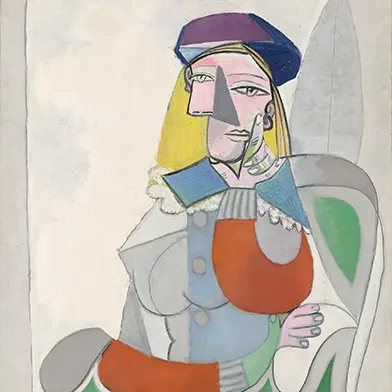British artist Maeve Gilmore (b.1917; d.1983) is one of the twentieth century’s ‘known unknowns’. Although she exhibited during her lifetime, Gilmore was best known for preserving and promoting the legacy of her husband, writer, artist and playwright, Mervyn Peake. However, following Gilmore’s first institutional exhibition at Studio Voltaire, London in 2022, there is now a long overdue recognition of her work, and she is finally acknowledged as a significant artist in her own right.
This exhibition offers a comprehensive overview spanning 42 years of paintings, works on paper and objects, contextualised with images of her hand painted murals, which once covered the walls of the family home in Drayton Gardens, Chelsea.
By bringing together all aspects of her creative output – from home making to art making – this exhibition offers an insight into Gilmore as a shrewd and loving observer of domestic life. She took particular delight in the playfulness of her children as they lost themselves in gymnastic stunts, in games of dressing-up, or cat’s cradle, but did not shy away from darker feelings around the coexistence of her domestic role and her steadfast dedication to making art.
Born in Brixton, Gilmore studied sculpture at Westminster School of Art, London and then at Bonn Art School, Germany. From 1936, she travelled around Europe, witnessing the rise of fascism and Hitler’s rallies. Visiting Paris to see the International Paris Exposition, Gilmore was able to see first-hand key works of modernism and the avant-garde. She was greatly inspired by works made and exhibited in 1937, including Alexander Calder’s Mercury Fountain, Joan Miro’s large mural Catalan Peasant in Revolt, and Picasso’s renowned anti-war painting Guernica.
Upon her return to Britain, Gilmore and Peake married, going on to have three children: Sebastian, Fabian and Clare. The family moved to Sark, in the Channel Islands, where Gilmore never ceased to paint. ‘Despite the eternal meals, the fights of one’s children, and the constant demands of domesticity’, she maintained a studio in her family home throughout the decades. ‘In those attic rooms,’ she wrote, ‘I entered the world of my own making, and the familiar smell of turpentine’.
Gilmore’s markedly modernist sensibility and Surrealist spirit is expressed through a highly personal set of symbols. Much of her work is autobiographical, depicting daily family life and events from a keenly feminine perspective, in imagery that is often dreamlike. Her painterly world includes the poetry of the everyday, from still lifes of onions, pears and mushrooms to pet cats and her children playing. Gilmore’s paintings present a carefully constructed interior world, replete with Surrealist imagery as well as portraits of her family, which place domestic scenes centre-stage. For Gilmore, there was never a contradiction between female domesticity and a lifelong commitment to the arts. ‘I have never been able to divorce myself aesthetically, to decide between life and painting… My mainspring has always been the heart and not the head’.
Maeve Gilmore, Boys in Orchard, c.1954 © Maeve Gilmore Estat


